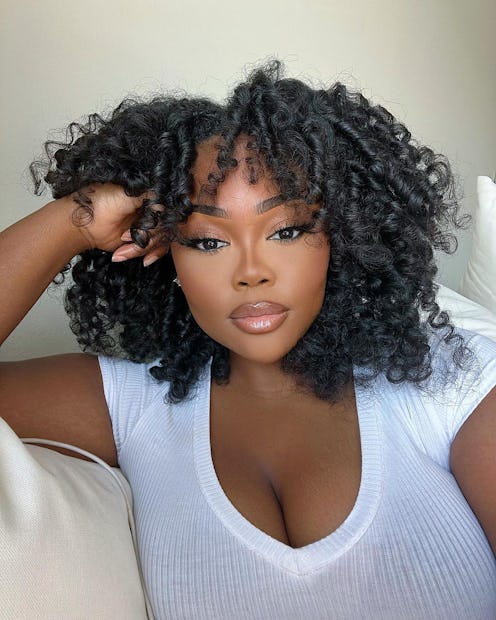(Hair)
Hair Cycling Is TikTok's Answer To Healthy, Shiny Hair
And hairstylists approve.

As fun and versatile as natural curls are, they tend to have a life of their own, occasionally taking a different form regardless of manipulation. For the most part, my 4A curls live a bouncy life as I cocktail different conditioning and hydrating products to encourage their natural spiral shape. But every couple months, my product assortment and routine start to plateau, producing buildup and dryness — convincing me to change things up in order to keep them happy and healthy. As it turns out, this consistent changing of routine (aka, hair cycling) is not only TikTok-approved, but extremely beneficial for all hair types.
The viral phenomenon known as hair cycling is similar to skin cycling in that it “applies rest days to an alternating hair routine to allow the hair to repair itself after certain products,” says Nikki Lee, celebrity stylist and Garnier celebrity colorist. For example, instead of using strong clarifying shampoos or deeply hydrating hair masks each time you wash your hair, you space them out throughout the week or month (duration will vary depending on the state of your hair) to give your locks time to rest and recharge. Focused on allowing natural hair oils to work optimally, the overall goal of hair cycling is to not over-strip or over-cleanse the hair and keep it at its healthiest state. By doing so, you will avoid the aforementioned product build-up, dandruff, and overproduction of oil.
Intrigued to learn if hair cycling is right for you? Keep reading to hear from top celebrity hairstylists as they break down the inspiration behind the trend, benefits, how to execute, and how to maintain.
What Are The Benefits Of Hair Cycling?
As hair cycling looks to improve the health of the hair and scalp, all hair types can benefit from the buzzy trend. First, hair cycling reduces the risk of inflammation. Like the skin on your face, over-exfoliating or too many steps in your routine can irritate the scalp, compromising the balance of the scalp biome and follicles. All this could lead to redness, itchiness, irritation, and enhanced inflammation of the scalp.
Hair cycling also targets the specific needs of your hair at a specific time. According to Rodger Azadganian, founder of Äz Craft Luxury Haircare, the more you get to know your hair through cycling, the better you’ll be able to gauge if it needs products to encourage hydration, shine, or prevent damage. (For example, if you are struggling with dehydration, you can create a wash day that focuses on nourishing hair masks and leave-in conditioners to lock in moisture.)
How To Apply Hair Cycling To A Weekly Routine
Although each hair cycling routine is based off of lifestyle, hair type, and how often hair is cleansed, according to Jonathan Colombini, L’Oréal Paris celebrity hairstylist and colorist, the entire process yields three cycles (washes).
Cycle 1
The experts all agree that the first wash should center on detoxifying the hair. “Start the cycle with a detox or clarifying shampoo to get rid of product that’s built up on hair, dulling it overtime,” Lee tells TZR. If you don’t have a detox or clarifying shampoo on hand, you can always use a shampoo brush like Coco & Eve to gently massage and exfoliate the scalp. Next, work in a leave-in overnight, ultra-hydrating mask to restore moisture into the hair.
Cycle 2
The next time you wash your hair, regardless of how many days in between, use bond-building products that help repair. These types of formulas (typically in masks) restore the hydrogen bonds and replenish the protein, repairing the damaged hair follicles. For those that experiment with color or other chemical processes, bond-building should be apart of your weekly routine.
Cycle 3
Lastly, for ideal styling, work in a volumizing, smoothing, or hydrating leave-in conditioning spray or products formulated with fatty acids, antioxidants, and proteins to lock in moisture and natural oils, fight frizz, and repair chemical damages.